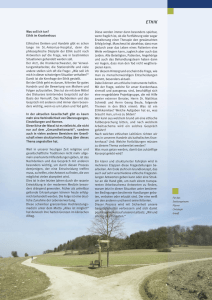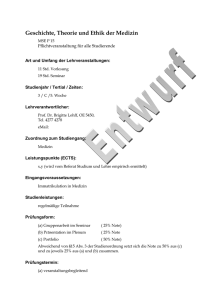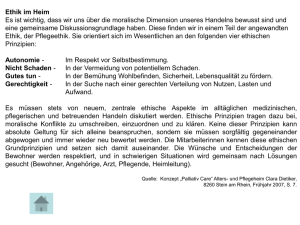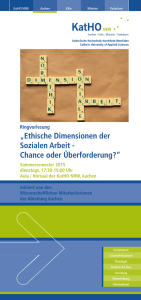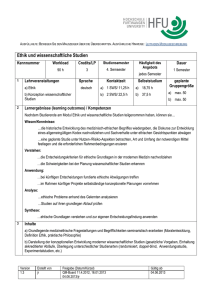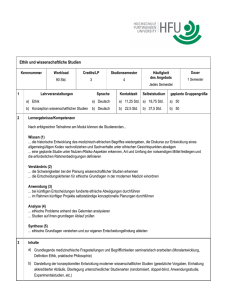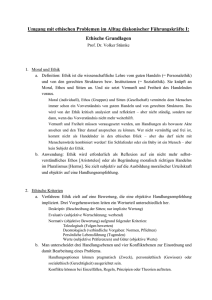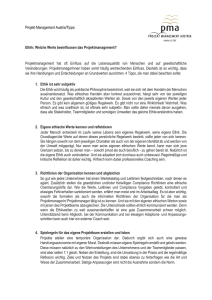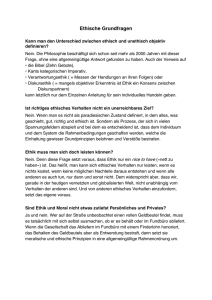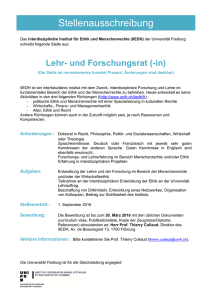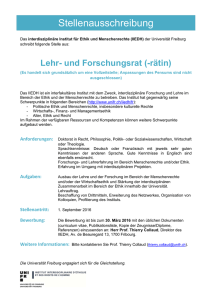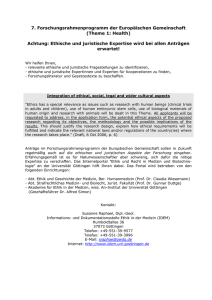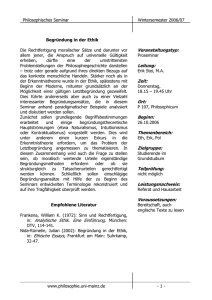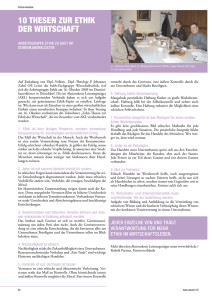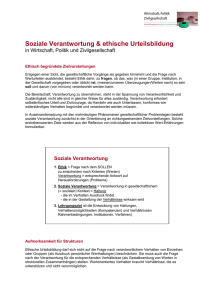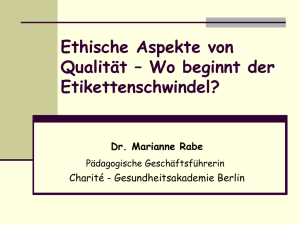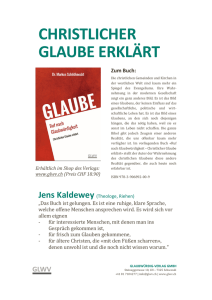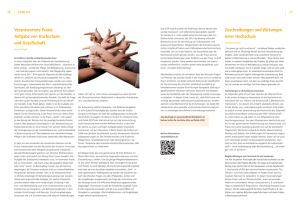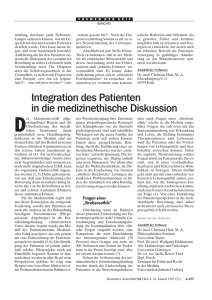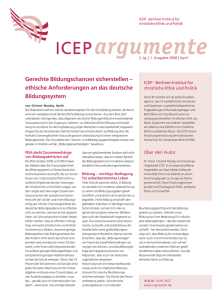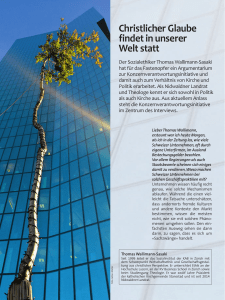Inhalt - STARK Verlag
Werbung
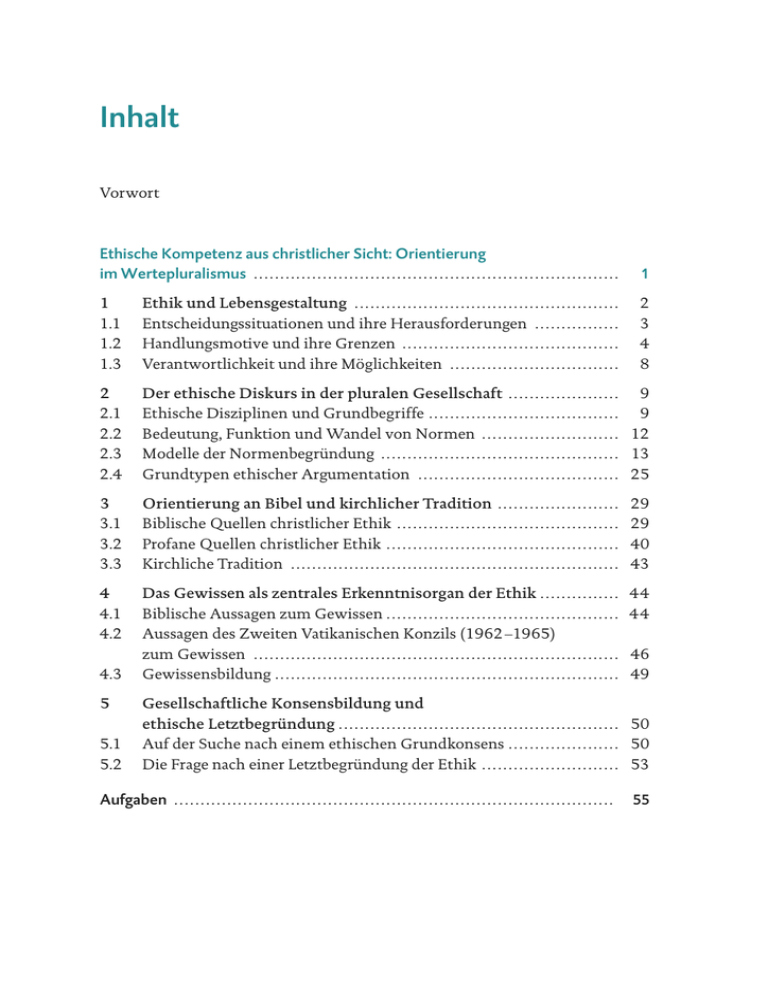
Inhalt Vorwort Ethische Kompetenz aus christlicher Sicht: Orientierung im Wertepluralismus . . . . . . . . . . . . . . . . . . . . . . . . . . . . . . . . . . . . . . . . . . . . . . . . . . . . . . . . . . . . . . . . . . . . . 1 1 1.1 1.2 1.3 Ethik und Lebensgestaltung . . . . . . . . . . . . . . . . . . . . . . . . . . . . . . . . . . . . . . . . . . . . . . . . . . Entscheidungssituationen und ihre Herausforderungen . . . . . . . . . . . . . . . . Handlungsmotive und ihre Grenzen . . . . . . . . . . . . . . . . . . . . . . . . . . . . . . . . . . . . . . . . . Verantwortlichkeit und ihre Möglichkeiten . . . . . . . . . . . . . . . . . . . . . . . . . . . . . . . . 2 3 4 8 2 2.1 2.2 2.3 2.4 Der ethische Diskurs in der pluralen Gesellschaft . . . . . . . . . . . . . . . . . . . . . 9 Ethische Disziplinen und Grundbegriffe . . . . . . . . . . . . . . . . . . . . . . . . . . . . . . . . . . . . 9 Bedeutung, Funktion und Wandel von Normen . . . . . . . . . . . . . . . . . . . . . . . . . . 12 Modelle der Normenbegründung . . . . . . . . . . . . . . . . . . . . . . . . . . . . . . . . . . . . . . . . . . . . . 13 Grundtypen ethischer Argumentation . . . . . . . . . . . . . . . . . . . . . . . . . . . . . . . . . . . . . . 25 3 3.1 3.2 3.3 Orientierung an Bibel und kirchlicher Tradition . . . . . . . . . . . . . . . . . . . . . . . Biblische Quellen christlicher Ethik . . . . . . . . . . . . . . . . . . . . . . . . . . . . . . . . . . . . . . . . . . Profane Quellen christlicher Ethik . . . . . . . . . . . . . . . . . . . . . . . . . . . . . . . . . . . . . . . . . . . . Kirchliche Tradition . . . . . . . . . . . . . . . . . . . . . . . . . . . . . . . . . . . . . . . . . . . . . . . . . . . . . . . . . . . . . . 29 29 40 43 4 4.1 4.2 Das Gewissen als zentrales Erkenntnisorgan der Ethik . . . . . . . . . . . . . . . Biblische Aussagen zum Gewissen . . . . . . . . . . . . . . . . . . . . . . . . . . . . . . . . . . . . . . . . . . . . Aussagen des Zweiten Vatikanischen Konzils (1962 –1965) zum Gewissen . . . . . . . . . . . . . . . . . . . . . . . . . . . . . . . . . . . . . . . . . . . . . . . . . . . . . . . . . . . . . . . . . . . . . Gewissensbildung . . . . . . . . . . . . . . . . . . . . . . . . . . . . . . . . . . . . . . . . . . . . . . . . . . . . . . . . . . . . . . . . . 44 44 4.3 5 5.1 5.2 46 49 Gesellschaftliche Konsensbildung und ethische Letztbegründung . . . . . . . . . . . . . . . . . . . . . . . . . . . . . . . . . . . . . . . . . . . . . . . . . . . . . 50 Auf der Suche nach einem ethischen Grundkonsens . . . . . . . . . . . . . . . . . . . . . 50 Die Frage nach einer Letztbegründung der Ethik . . . . . . . . . . . . . . . . . . . . . . . . . . 53 Aufgaben . . . . . . . . . . . . . . . . . . . . . . . . . . . . . . . . . . . . . . . . . . . . . . . . . . . . . . . . . . . . . . . . . . . . . . . . . . . . . . . . . . . 55 Ethische Kompetenz aus christlicher Sicht: Aktuelle Herausforderungen der christlichen Sozialethik . . . . . . . . . . . . . . . . . . . . . . . . . . . . . . . . . . . . . . . . . . . . . . . . . . . . . . . . . . . 57 1 1.1 1.2 1.3 1.4 Partnerschaft, Ehe und Familie . . . . . . . . . . . . . . . . . . . . . . . . . . . . . . . . . . . . . . . . . . . . . . Partnerschaft als personaler Gestaltungsraum . . . . . . . . . . . . . . . . . . . . . . . . . . . . . Das katholische Eheverständnis . . . . . . . . . . . . . . . . . . . . . . . . . . . . . . . . . . . . . . . . . . . . . . . Die Familie aus katholischer Sicht . . . . . . . . . . . . . . . . . . . . . . . . . . . . . . . . . . . . . . . . . . . . Die Berufung zur Ehelosigkeit . . . . . . . . . . . . . . . . . . . . . . . . . . . . . . . . . . . . . . . . . . . . . . . . . 58 59 62 69 72 2 2.1 2.2 Die Menschenrechte als Grundlage eines globalen Ethos . . . . . . . . . . . Die „Allgemeine Erklärung der Menschenrechte“ . . . . . . . . . . . . . . . . . . . . . . . . Chancen und Schwierigkeiten bei der Verwirklichung der Menschenrechte . . . . . . . . . . . . . . . . . . . . . . . . . . . . . . . . . . . . . . . . . . . . . . . . . . . . . . . . . . . . . . Das Projekt „Weltethos“ . . . . . . . . . . . . . . . . . . . . . . . . . . . . . . . . . . . . . . . . . . . . . . . . . . . . . . . . Die Verantwortung der Kirche für die Verwirklichung der Menschenrechte . . . . . . . . . . . . . . . . . . . . . . . . . . . . . . . . . . . . . . . . . . . . . . . . . . . . . . . . . . . . . . 74 75 2.3 2.4 78 82 83 3 3.1 3.2 3.3 3.4 3.5 Grundlagen und Methoden der katholischen Sozialethik . . . . . . . . . . . 87 Schritte ethischer Urteilsbildung . . . . . . . . . . . . . . . . . . . . . . . . . . . . . . . . . . . . . . . . . . . . . . 88 Anthropologische Grundlagen der Sozialethik . . . . . . . . . . . . . . . . . . . . . . . . . . . . 92 Gerechtigkeit als zentrales Ideal biblisch-christlicher Sozialethik . . . . . 94 Entwicklung und Anliegen der katholischen Soziallehre . . . . . . . . . . . . . . . . 99 Die Prinzipien der katholischen Soziallehre . . . . . . . . . . . . . . . . . . . . . . . . . . . . . . . . 105 4 Christliche Tugenden und ethisches Handeln . . . . . . . . . . . . . . . . . . . . . . . . . . 110 Aufgaben . . . . . . . . . . . . . . . . . . . . . . . . . . . . . . . . . . . . . . . . . . . . . . . . . . . . . . . . . . . . . . . . . . . . . . . . . . . . . . . . . . . 114 Dimensionen der Zukunft – Gestaltungsauftrag für die Gegenwart . . . . . . . . . . . 117 1 1.1 1.2 1.3 Lebensvisionen junger Erwachsener . . . . . . . . . . . . . . . . . . . . . . . . . . . . . . . . . . . . . . . 118 Einstellungen junger Menschen zur Zukunft . . . . . . . . . . . . . . . . . . . . . . . . . . . . . . . 118 Aktuelle Problemfelder der Zukunftsforschung im Überblick . . . . . . . . . 121 Exemplarische Handlungsfelder der Zukunft . . . . . . . . . . . . . . . . . . . . . . . . . . . . . . 124 2 2.1 2.2 Säkulare Zukunftsmodelle . . . . . . . . . . . . . . . . . . . . . . . . . . . . . . . . . . . . . . . . . . . . . . . . . . . . 134 Zukunftsforschung oder „Futurologie“ . . . . . . . . . . . . . . . . . . . . . . . . . . . . . . . . . . . . . . 134 Utopien . . . . . . . . . . . . . . . . . . . . . . . . . . . . . . . . . . . . . . . . . . . . . . . . . . . . . . . . . . . . . . . . . . . . . . . . . . . . . . 139 3 3.1 3.2 3.3 Christliche Zukunftshoffnung . . . . . . . . . . . . . . . . . . . . . . . . . . . . . . . . . . . . . . . . . . . . . . . 143 Utopien in der alttestamentlichen Prophetie . . . . . . . . . . . . . . . . . . . . . . . . . . . . . . . 145 Apokalyptische Aussagen der Bibel . . . . . . . . . . . . . . . . . . . . . . . . . . . . . . . . . . . . . . . . . . . 148 Die Reich-Gottes-Botschaft als Fundament christlicher Zukunftshoffnung . . . . . . . . . . . . . . . . . . . . . . . . . . . . . . . . . . . . . . . . . . . . . . . . . 158 3.4 3.5 Auferstehung und Auferweckung als Zentrum christlicher Eschatologie . . . . . . . . . . . . . . . . . . . . . . . . . . . . . . . . . . . . . . . . . . . . . . . . . . . . . . . . . 167 Die biblische Rede vom Gericht als Hoffnungsbotschaft . . . . . . . . . . . . . . . . 171 4 4.1 4.2 4.3 Impulse zur Weltgestaltung aus christlicher Zukunftserwartung 175 Weltverantwortung und eschatologischer Vorbehalt . . . . . . . . . . . . . . . . . . . . . 177 Gelassenheit und Mut zur Veränderung . . . . . . . . . . . . . . . . . . . . . . . . . . . . . . . . . . . . . 178 Hoffnung trotz Versagen . . . . . . . . . . . . . . . . . . . . . . . . . . . . . . . . . . . . . . . . . . . . . . . . . . . . . . . . 179 Aufgaben . . . . . . . . . . . . . . . . . . . . . . . . . . . . . . . . . . . . . . . . . . . . . . . . . . . . . . . . . . . . . . . . . . . . . . . . . . . . . . . . . . . 181 Grundriss einer Zusammenschau – das christliche Credo . . . . . . . . . . . . . . . . . . . . . . . . 183 1 1.1 1.2 „Ich glaube“ – Glaube als existenzielle Grundorientierung . . . . . . . . . 184 Glaube als Haltung und Inhalt . . . . . . . . . . . . . . . . . . . . . . . . . . . . . . . . . . . . . . . . . . . . . . . . . 184 Glauben als personaler Akt . . . . . . . . . . . . . . . . . . . . . . . . . . . . . . . . . . . . . . . . . . . . . . . . . . . . . 185 2 2.1 2.2 „Wir glauben“ – Das Apostolische Glaubensbekenntnis (Credo) . 188 Die Entstehung des Apostolicums . . . . . . . . . . . . . . . . . . . . . . . . . . . . . . . . . . . . . . . . . . . . 188 Die Bedeutung des Apostolicums . . . . . . . . . . . . . . . . . . . . . . . . . . . . . . . . . . . . . . . . . . . . . 191 3 3.1 3.2 3.3 3.4 Vater, Sohn und Heiliger Geist . . . . . . . . . . . . . . . . . . . . . . . . . . . . . . . . . . . . . . . . . . . . . . . 193 Gott der Schöpfer: Vater und Herr der Welt . . . . . . . . . . . . . . . . . . . . . . . . . . . . . . . . 193 Jesus Christus: Sohn Gottes und Erlöser der Menschen . . . . . . . . . . . . . . . . . 196 Heiliger Geist: Beistand und Lebenskraft . . . . . . . . . . . . . . . . . . . . . . . . . . . . . . . . . . . . 199 Trinitarisches Gottesverständnis und menschliche Deutungsversuche . . . . . . . . . . . . . . . . . . . . . . . . . . . . . . . . . . . . . . . . . . . . . . . . . . . . . . . . . . . . . . . . 202 Lösungen . . . . . . . . . . . . . . . . . . . . . . . . . . . . . . . . . . . . . . . . . . . . . . . . . . . . . . . . . . . . . . . . . . . . . . . . . . . . . . . . . . . . 205 Stichwortverzeichnis . . . . . . . . . . . . . . . . . . . . . . . . . . . . . . . . . . . . . . . . . . . . . . . . . . . . . . . . . . . . . . . . . . . . . 219 Bildnachweis . . . . . . . . . . . . . . . . . . . . . . . . . . . . . . . . . . . . . . . . . . . . . . . . . . . . . . . . . . . . . . . . . . . . . . . . . . . . . . . 221 Autor: Thomas Gottfried
